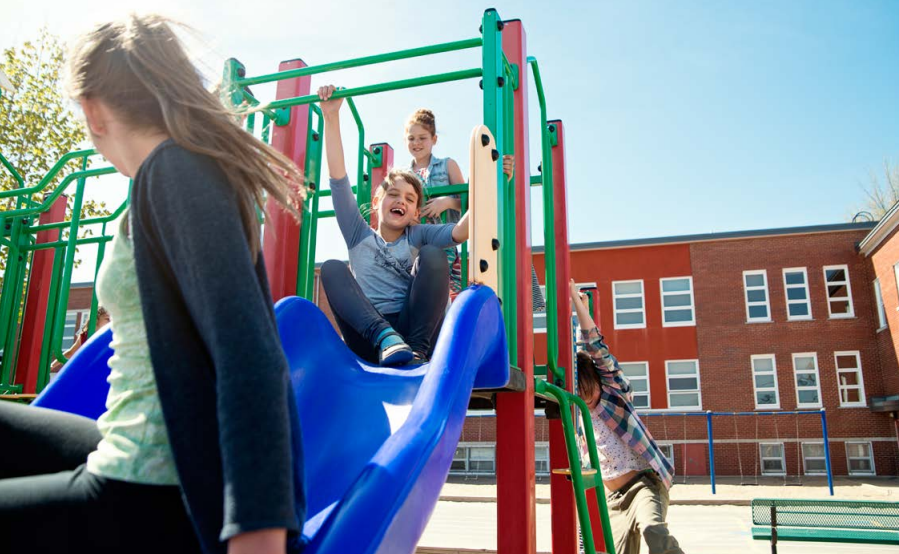Survey Results: Healthy School Learning Communities of Practice

Previously published in Volume 82, Issue 1
Introduction
Physical and Health Education Canada’s (PHE Canada) Health Promoting Schools Initiative (HPS) is aimed at supporting school community efforts to ensure all children and youth in Canada live healthy, physically active lives. Through positive change in practices within the school community, children and youth will be nurtured to achieve their best – both in terms of academic progress and in their physical, emotional and social development. A whole-school approach recognizes the relationship between health and learning, and when students are healthy, learning outcomes are positively affected.
In 2011, PHE Canada embarked on a process with funding support from the Lawson Foundation to assist schools in their efforts to move toward healthier outcomes. The primary goals of the project were to promote and support systemic change among the members of a school community that would inspire greater physical activity, healthy eating and emotional well-being, and to begin addressing the psycho-social and environmental factors that influence the overall health of schools, families and communities as an integrated system.
To achieve this, PHE Canada developed a process to assist schools to become more comprehensive in their approach to school health by embracing the Comprehensive School Health (CSH) Framework (and its many provincial variations) developed by the Joint Consortium for School Health (JCSH). The process involved forming a Healthy Schools Learning Community of Practice (COP) of a minimum 8-10 schools to provide mutual support, foster collaborative learning and action, gather collective courage to push forward with change, and ensure sustainability of efforts through group strengths. The process involves certain key components designed to guide participating schools toward adoption of the CSH Framework. Research has shown that schools that adopt the Framework are able to push their school communities to better health outcomes.
Between November 2014 and May 2015, PHE Canada identified five COPs - Anglophone West School District, NB; Near North District School Board, ON; Okanagan Skaha School District, BC; Saskatoon Public Schools, SK; and York Region District School Board, ON. School teams participated in a two-day planning process to learn how to help a school embrace the CSH Framework and form a plan to become a healthier school community. To gauge the schools’ progress toward achieving the goals outlined in their Healthy School Action Plan, PHE Canada conducted a follow up survey in February 2016.
The report below summarizes key points extracted from the survey.
COP composition—school health teams
The composition of survey respondents’ Healthy School Teams includes both teachers and principals, but also a diverse mix of other members from within the school and from the larger community. Of the 40 respondents, 51% indicated that the composition of their Healthy School Team had changed since participating in a COP workshop last spring. As expected, some of the changes to team composition were due to staff turnover, but many schools also took measures to engage with more members of the school community. Within the school, some Healthy School Teams reached out to educational assistants, school health nurses, and other support staff, as well as students, for help working towards advancing their Healthy School Action Plan goals. Schools also recruited team members from the community at large, some with specialized health knowledge (e.g. dieticians, Public health Nurses, community stakeholders, volunteers). The composition of Healthy School Teams can be seen below in Figure 1.
Figure 1. Percentage of Healthy School Teams that include members from certain domains.
Implementation of healthy school action plan
Figure 2 below shows that 50% of respondents said that their schools were progressing as planned, and a further 12% said that they were well under way and building upon their goals. Some of the successes of schools are described below:
Figure 2. Percentage of Healthy School Teams at given stages of Healthy School Action Plan implementation.
What the schools are saying
For many of the schools, improved nutrition and increased physical activity among students were the focus of Healthy School Action Plans, but psychosocial improvements have also been observed as a consequence of involvement in school health initiatives.
“[Our] breakfast program is up and serving many students and staff every day.”
“Although we had many goals, we have chosen to focus on setting up a school-wide daily breakfast program, providing nutritional baskets in each classroom containing healthy food to supplement students' lunches and providing a dance/active movement opportunity during recess (particularly during the cold indoor days). The healthy food programs are up and running fairly smoothly but we haven't organized the active movement group opportunities.”
“The amount of students this year participating in physical activity has increased by 15%. We currently have full teams of any school sports team. We had 92% participation [in] our last school wide in-motion activity.”
“School was linked to other health unit services (Public Health Inspector) through involving a public health unit staff in the Healthy School Team.”
“We are still in the process of gathering data - from the initial data I think that we are well on our way [to] achieving the goal of healthy eating: that every student will eat at least one serving of fresh fruit/fresh vegetable at school every day”
“Since we have put our Breakfast program into place, students attending have encouraged each other to try out/join school organized sports/join in organized and unorganized outdoor physical activities during recess.”
“On our Tell Them From Me Survey, some of the students that have been most engaged in the process reported responses that were surprising regarding an increased sense of belonging and connectedness.”
Supporting the COP—key areas of need
While many schools have achieved success with the implementation of their Healthy School Plans, 29% of respondents indicated that they were still in the beginning phase of the process, and 9% said that they had yet to get started (Figure 2). Schools face many challenges to implementing and maintaining school health initiatives, and they need support in some key areas if they are to succeed. Respondents were asked to identify challenges or barriers to sustainability and strategies or solutions that could be explored to support their planning and implementation.
Figure 3. Percentage of Healthy School Teams experiencing different challenges or barriers to sustainability of school health initiatives.
In terms of challenges or barriers to program sustainability, 58% of respondents cited a lack of resources (time, human, materials) as a major factor impeding the implementation of their Healthy School Action Plan (Figure 3). In particular, schools cited difficulty finding time for Healthy School Teams to meet regularly due to other commitments, and this difficulty was compounded by the diverse makeup of the team (e.g. teachers preparing student report cards, health nurses’ limited availability, student participation in other school activities). In some schools, time barriers make even assembling a team a difficult task. Some Healthy School Teams would like their school districts to demonstrate support by offering professional development time to further their Healthy School Action Plan.
In addition to time barriers, 35% of respondents cited a lack of funding as a major barrier impeding program sustainability (Figure 3), mentioning in particular a lack of consistent funding and how that made it difficult to implement and maintain initiatives from year to year.
A further 23% of respondents cited changes in team composition as a barrier to sustainability (Figure 3). While some schools have made efforts to improve the sustainability of their Healthy School Action Plan by involving multiple team members in leadership roles on Healthy School Teams, often high staff and student turnover interrupts the progress towards school health goals.
Figure 4. Percentage of Healthy School Teams that would like to explore different strategies or solutions to support implementation of Healthy School Action Plans.
In regards to strategies and solutions for supporting the implementation of Healthy School Action Plans, 81% of respondents believe that building capacity in the school and community is an important strategy for success (Figure 4). As one school said, “[the plan] will only remain alive if we continue to weave it into what we do within school programming.” For example, schools hope that integrating aspects of their Healthy School Action Plans into the daily responsibilities of staff and passing student responsibilities from older to younger students will improve the sustainability of health initiatives even when funding is limited or unavailable. The involvement of Public Health Nurses and parent volunteers in the implementation of the Healthy School Action Plan is another way that schools build capacity through the community.
In addition to building capacity, 58% of respondents view connecting with other Healthy School Teams as essential for attaining health goals (Figure 4). While some schools in the same COP stayed in contact after the PHE Canada workshop, others found it challenging to maintain a relationship and said that although the networking that happened during the workshop was extremely useful, ongoing sessions would allow schools to further benefit from networking both with other schools in the same COP and with community partners.
Building capacity and connecting with other schools are both essential to the future success of Healthy School Action Plans, but there is a need for further funding to support these processes, particularly when schools are in the beginning of the COP process. 58% of respondents said that exploring new funding avenues would help them to effectively implement their Healthy School Action Plan (Figure 4), and many schools described how a lack of adequate funding undermined efforts to introduce and maintain health initiatives. For example, one school noted that a lack of consistent funding made it difficult to maintain food programs. Another school described the difficulty in deciding whether to allocate limited funds to directly supporting meaningful activities or initiatives, or to use them for release time for staff involved in implementing the programs.
Conclusion
The results of this follow-up survey provide valuable insight for future enhancements locally within each school’s own jurisdiction and to PHE Canada nationally. Following the workshops, Healthy School Teams returned to their respective schools to engage their communities and further develop their Healthy Schools Plans. As described by respondents in the survey, many schools were able to implement what they learned in the workshop in progressing toward their school’s health goals and experiencing success through the implementation of health activities and initiatives, particularly those that addressed the nutrition and physical activity levels of students. Respondents described the COP workshops as “extremely useful,” and as being “rooted in good work that is sustainable,” and they would like continued opportunities to participate in activities that allow networking within a COP.
Healthy School Teams are enthusiastic about their progress thus far, but the feedback they provided has given PHE Canada important direction regarding how best to support schools’ development going forward. Despite efforts to build sustainability and capacity within school health programming, many schools continue to struggle with limited staff availability due to time constraints. Working to obtain further support locally from school districts in the form of professional development time designated to furthering Healthy Schools Plans is one avenue that can be explored to address this obstacle. Inconsistent funding also poses a barrier to sustainability, as it prevents some schools from implementing initiatives that have been successful in previous years. Especially when schools are in the initial stages of building capacity, adequate time and funds are critical to enable proper development that will ensure the sustainability of healthy school programs going forward.









